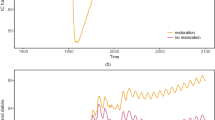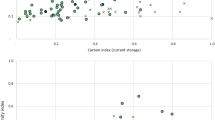Abstract
This paper presents an optimal control model to analyze reforestations with two different species, including commercial values, carbon sequestration and biodiversity or scenic values. We discuss the implications of partial or total internalization of environmental values, showing that internalizing only carbon sequestration may have negative impacts on biodiversity-scenic values. To evaluate the practical relevance, we compare reforestations in the South-west of Spain with cork-oaks (a slow-growing native species) and with eucalyptus (a fast-growing alien species). We do the analysis with two different carbon crediting methods: the Carbon Flow Method and the Ton Year Accounting Method. With the first method, the forest surface increases more, but using mainly eucalyptus. With the second, additional reforestations are done mainly using cork-oaks. We value the impact on visitors of these reforestations using stated preferences methods showing that, when these values are internalized, cork-oaks are favored.
Similar content being viewed by others
References
Boletin Oficial del Estado (BOE) (2001) Real Decreto 6/2001, de 12 de enero, sobre fomento de la forestación de tierras agrícolas. BOE 12(13.1.2001):1621–1630
Campos P, Daly-Hassen H, Ovando P (2007) Cork-oak forest management in Spain and Tunisia: two case studies of conflicts between sustainability and private income. Int For Rev 9(2): 610–626
Campos P, Ovando P, Oviedo JL, López E, Montero G (2009) Economía privada de la forestación con alcornoques y la regeneración natural del alcornocal en el Parque Natural Los Alcornocales (Cádiz - Málaga). In: Zapata-Blanco S (eds) Alcornocales e industria corchera: Hoy, Ayer y Mañana. Museu del Suro de Palafrugell, Palafrugell, Spain (Forthcoming)
Cunha-e-Sá MA, Rosa R (2006) Impact of carbon accounting methods on optimal forest management: an application to the Portuguese eucalyptus forest. II AERNA Congress, Lisbon (2–3 June)
Caparrós A, Campos A, Martín D (2003) Influence of carbon dioxide abatement and recreational services on optimal forest rotation. Int J Sustain Dev 6(3): 345–358
Caparrós A, Cerdá E, Ovando P, Campos P (2007) Carbon Sequestration with reforestations and biodiversity-scenic values. FEEM Working Paper 28.2007, Milan
Caparrós A, Oviedo JL, Campos P (2008) Would you choose your preferred option? Comparing choice and recoded ranking experiments. Am J Agricult Econ 90(3): 843–855
Caparrós A, Jacquemont F (2003) Conflicts between biodiversity and carbon offset programs: economic and legal implications. Ecol Econ 46: 143–157
Carnus J-M, Parrotta J, Brockerhoff E, Arbez M, Jactel H, Kremer A, Lamb D, O’Hara K, Walters B (2006) Planted forests and biodiversity. J For 104(2): 65–77
Cowling RM, Rundel PW, Lamont BB, Arroyo MK, Arianoutsou M (1996) Plant diversity in mediterranean-climate regions. Trends Ecol Evol 11(9): 362–366
Dockner E (1985) Local stability in optimal control problems with two state variables. In: Feichtinger G Optimal control theory and economic analysis 2. North-Holland, Amsterdam, pp 89–103
Englin J, Callaway JM (1993) Global climate change and optimal forest management. Nat Resour Model 7(3): 191–202
Feng H, Zhao J, Kling CL (2002) The time path and implementation of carbon sequestration. Am J Agricult Econ 84(1): 134–149
Feng H, Kling CL (2005) The consequences of cobenefits for the efficient design of carbon sequestration programs. Can J Agricult Econ 53: 461–476
García O (1983) A stochastic differential equation model for the height growth of forest stands. Biometrics 39: 1059–1072
Hartman R (1976) The harvesting decision when a standing forest has value. Econ Inq 14: 52–58
Hunt C (2008) Economics and ecology of emerging markets and credits for bio-sequestered carbon on private land in tropical Australia. Ecol Econ 66(2-3): 309–318
Huntsinger L, Bartolome JW (1992) Ecological dynamics of Quercus dominated woodlands in California and southern Spain: a state-transition model. Vegetatio 99–100: 299–305
Intergovernmental Panel on Climate Change (IPCC) (2000) IPCC special report: land use, land use change and forestry. WMO–UNEP, Geneva
Krinsky I, Robb AL (1986) On approximating the statistical properties of elasticities. Rev Econ Stat 68: 715–719
Lubowski RN, Plantinga AJ, Stavins RN (2006) Land-use change and carbon sinks: Econometric estimation of the carbon sequestration supply function. J Environ Econ Manag 51: 135–152
Matthews S, O’Connor R, Plantinga AJ (2002) Quantifying the impacts on biodiversity of policies for carbon sequestration in forests. Ecol Econ 40(1): 71–87
McFadden D (1981) Econometric models of probabilistic choice. In: Manski C, McFadden D (eds) Structural analysis of discrete data with econometric applications. MIT Press, Cambridge, pp 198–272
Montero G, López E, Campos P, Sánchez-González MO, Sánchez M, Ruiz-Peinado R, Ovando P, Caparrós A, Bachiller, A (2009) Selvicultura de los alcornocales (Quercus suber L.) del macizo del Aljibe (Cádiz—Málaga). In: Zapata-Blanco S, (eds) Alcornocales e industria corchera: Hoy, Ayer y Mañana. Museu del Suro de Palafrugell, Palafrugell, Spain (Forthcoming)
Montero G, Ruiz-Peinado R, Muñoz M (2006) Producción de biomasa y fijación de CO2 por los bosques españoles Serie Forestal 13. Monografías Instituto Nacional de Investigación y Tecnología Agraria y Alimentaria, Madrid
Moons E, Proost S, Saveyn B, Hermy M (2008) Optimal location of new forests in a suburban region. J For Econ 14(1): 5–27
Moura-Costa P, Wilson C (2000) An equivalence factor between CO 2 avoided emissions and sequestration—description and applications in forestry. Mitig Adapt Strateg Glob Chang 5(1): 51–60
Muys B, Garcia-Quijano J, Deckmyn G, Ceulemans R, Moons E, Proost S (2003) An integrated decision support framework for the prediction and evaluation of efficiency environmental impact and total social cost of domestic and international forestry projects for greenhouse gas mitigation: description and case studies. KU Leuven Working Paper 2003–2006.
Official Journal of the European Communities (OJEC) (1999) Council regulation (EC) no. 1257/1999 of 17 May 1999, on support for rural development from the European Agricultural Guidance and Guarantee Fund (EAGGF) and amending and repealing certain Regulations. OJEC, L, vol. 160, 26.6.1999, pp. 80–102
Olschewski R, Benitez PC (2005) Secondary forests as temporary carbon sinks? The economic impact of accounting methods on reforestation projects in the tropics. Ecol Econ 55: 380–394
Richards KR, Sampson RN, Brown S (2006) Agricultural and forestlands: US carbon policy strategies. PEW Center, Washington
Richards KR, Stokes C (2004) A review of forest carbon sequestration cost studies: a dozen years of research. Clim Chang 63: 1–48
Sohngen B, Mendelsohn R (2003) An optimal control model of forest carbon sequestration. Am J Agricult Econ 85(2): 448–457
Van Kooten GC, Binkley CS, Delcourt G (1995) Effects of carbon taxes and subsidies on optimal forest rotation age and supply of carbon services. Am J Agricult Econ 77: 365–374
Van Kooten GC (2000) Economic dynamics of tree planting for carbon uptake on marginal agricultural lands. Can J Agricult Econ 48: 51–65
Van’t Veld K, Plantinga A (2005) Carbon sequestration or abatement? The effect of rising carbon prices on the optimal portfolio of greenhouse-gas mitigation strategies. J Environ Econ Manag 50: 59–81
Author information
Authors and Affiliations
Corresponding author
Rights and permissions
About this article
Cite this article
Caparrós, A., Cerdá, E., Ovando, P. et al. Carbon Sequestration with Reforestations and Biodiversity-scenic Values. Environ Resource Econ 45, 49–72 (2010). https://doi.org/10.1007/s10640-009-9305-5
Received:
Accepted:
Published:
Issue Date:
DOI: https://doi.org/10.1007/s10640-009-9305-5




